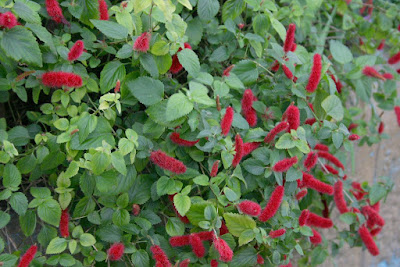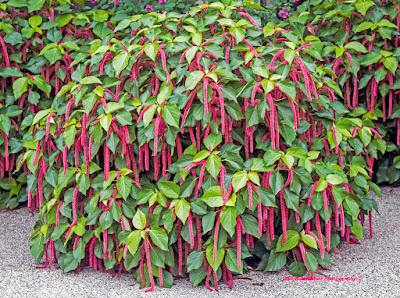Acalypha are mainly grown in tropical and subtropical regions (but not found in Hawaii and a few other islands in the Pacific Ocean ), and only a few species live in temperate regions. Native North American species are generally inconspicuous most of the year until the fall when their stems and foliage turn a distinctive coppery-red.
Acalypha also called as Copperleaf, Three-seeded mercury, Acalyphes, Acalyphopsis, Calyptrospatha, Caturus, Corythea, Cupameni, Galurus, Gymnalypha, Linostachys, Mercuriastrum, Odonteilema, Paracelsea, Ricinocarpus, Schizogyne, Usteria, is a genus of the family Euphorbiaceae. This genus was described by Carl Linnaeus in 1753.
IDENTIFY ACALYPHA PLANT
Acalypha are mainly grown in tropical and subtropical regions (but not found in Hawaii and a few other islands in the Pacific Ocean ), and only a few species live in temperate regions. Native North American species are generally inconspicuous most of the year until the fall when their stems and foliage turn a distinctive coppery-red.
Copperleaf are annuals or perennial herbs, shrubs, and small trees with alternate leaves, stipules lanceolate or subulate, sometimes minute, deciduous. The leaf blade is simple, margins crenate or dentate, rarely subentire; venation pinnate or palmate.
Three-seeded mercury blooms from the axillary or terminal inflorescences, mostly unbranched, bisexual or unisexual, sexes very diversely arranged, mostly bisexual with male flowers in fascicles distally along slender axis, base with 1 to few female flowers, mostly enclosed within prominent leafy bracts.
Some common species of this genus: Acalypha chamaedrifolia (light green, heart-shaped leaves with spiciform, pubescent, bright red, drooping inflorescences), Acalypha godseffiana (bronze-greenish leaves with bright copper-red spots), Acalypha hispida (beautiful bright red blossoms with drooping spike inflorescences), Acalypha wilkesiana (bronze-greenish leaves with bright copper-red spots).
ACALYPHA PLANT CARE AND CULTURE
Cultural information should only be used as a guide, and should be to be adapted to suit you. Your physical location; where you grow your plants, how much time you have to devote to their care, and many other factors, will need to be taken into account. Only then can you decide on the cultural methods that best suit you and your plants.
Light:
Acalypha prefers good lighting, but from direct sunlight it should be shaded. With a lack of light, the plant is drawn out, it blooms poorly, and the variegated forms lose their bright color.
Temperature:
Copperleaf need a minimum temperature between 12 ° C and 15 ° C, a good 22 ° C suits them perfectly. In summer, the optimum temperature for it is 20-24 ° С, in winter it is not lower than 16-18 ° С. If in winter the temperature is above the optimum, then water them more often.
Substrate and growing media:
The soil mixture for cultivation should be light, permeable to water and air. Its composition: turf, leaf soil, riding peat, sand, taken in equal proportion. In different sources, the ratio of parts of the substrate varies: 4 parts of sod, 1 part of leaf, 2 parts of greenhouse soil and 0.5 sand or sour high-moor peat and one part of leaf soil and sand.
Transplantation is done in spring, young plant should repot every year, adults plant only when necessary, in case of loss of decorativeness, the plant is renewed by rooting cuttings.
Watering:
From the beginning of spring to autumn they are watered abundantly. In winter, watering is reduced, making sure that the soil does not dry out. They need high humidity, so you need frequent spraying. To increase the humidity, you can put a pot with a plant in a container with wet peat (expanded clay, pebbles).
Fertilizer:
Acalypha need fertilizer from March to September, every two weeks with a liquid fertilizer for decorative plants or flowering plants for all varieties. Respect the dosage and add the fertilizer to your water. A fertilizer for green plants brings a lot of nitrogen, which would have the effect of pulling your Acalypha to hues more greenish than red or pink.
Pruning:
Pruning is done in spring. Young plants are also removing buds from the top shoots. For renewal of adult plants it is necessary to apply annual pruning. This procedure is carried out in February before the start of the growing season. All shoots are cut off at the plant, leaving hemp 25-30 cm high, after that the plant is constantly sprayed, it is possible to put on a transparent plastic bag for better adaptation.
Propagation:
Acalypha is propagated by seeds and apical cuttings. Seeds are sown in March-April, the substrate is used consisting of leaf earth and sand (1: 1). It is necessary to maintain a temperature of 20-22 ° C, when using a mini-greenhouse with underheating, germination of seeds occurs faster. Seedlings dive into the substrate consisting of leaf, sod land and sand (1: 1: 1,2).
Decorative cuttings of Acalypha propagated by cuttings in March, and deciduous-decorative ones throughout the year. For this, semi-woody apical shoots are used. Root in the sand or in a mixture of peat and sand (1: 1). The temperature should not be lower than 20-22 ° C. A mini-heated room with bottom heating gives good results, with a temperature in the range of 22-25 ° C. Periodical cuttings are sprayed and aired regularly. After the cuttings are rooted, they are planted in a substrate consisting of leaf, turf, peat land and sand (2: 1: 1: 1). For greater decoration, it is possible to plant several rooted plants in one pot (Acalypha hispida). Caring for young plants is the same as for an adult plant, but the bright sunshine should be taught gradually. 1.5 months after planting, nip must be done by removing the buds from the tops of the shoots.

















COMMENTS